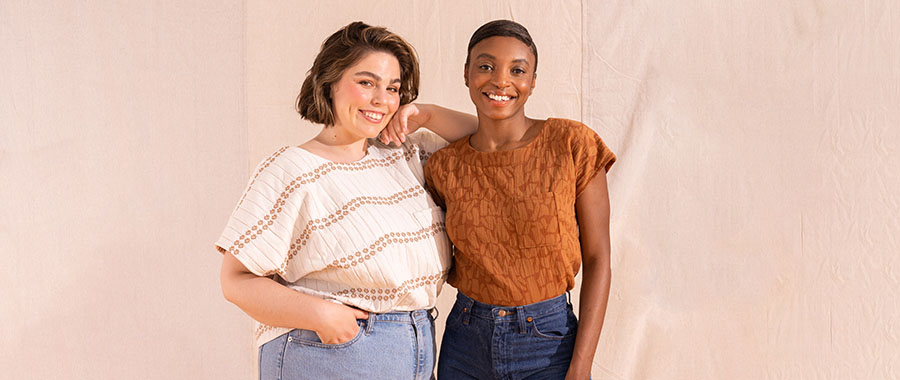After sewing for almost 30 years and helping thousands of people learn, I can honestly say there are a few steps that make learning to sew faster, more affordable, and a lot more fun. If I were learning to sew from the very beginning today, this is exactly what I would do.
Step One: Find an Inexpensive Sewing Machine
Think of your first sewing machine like a starter home—you don’t need all the luxury features to begin. In fact, if you can borrow a machine first, even better. Would you buy a horse before taking riding lessons? Of course not! You’d make sure you love riding first. The same applies here.
If borrowing isn’t an option, look for a basic used model. You only need a few essential features to get started:
- A straight stitch with adjustable length
- A simple zigzag stitch
- A reverse function
- An easily accessible bobbin
- A foot pedal with good control
You don’t need anything fancy. With just a straight stitch and zigzag, you can create beautiful things and build the skills you need to tackle more advanced techniques later on.
Step Two: Gather Your Essential Sewing Tools
Keep your tool kit simple and budget-friendly to start. Here are the must-haves:
- Fabric scissors: Label these and never use them on paper! A good pair of fabric shears makes cutting so much easier.
- Paper scissors: Use these for cutting patterns.
- Straight pins and a pincushion: Glass head pins are a great choice since they won’t melt under an iron.
- A seam ripper: Trust me, everyone uses one!
- Measuring tape: For accurate measurements every time.
- An iron and ironing board: You probably already have these at home.
- Machine needles: Keep a few sizes on hand.
- A clear ruler: Perfect for precise measurements.
- Marking tools: Chalk or washable pens work great for marking fabric.
-
These tools are all you really need to get started. If you want a more complete guide to sewing tools, we’ve created a free beginner-friendly sewing tools guide, complete with a handy needle guide and more. [Insert link here].
Step Three: Start With Simple Projects
This is where many beginners get stuck. They try to tackle something too complicated, get overwhelmed, and give up. Instead, start with easy wins – projects made from simple rectangles:
- An envelope-style pillowcase
- An unlined tote bag
- A set of kitchen tea towels
You might be thinking: boring. But here’s the secret: fabric choice is everything. When the project is simple, the fabric gets to shine. Plus, these are things you’ll use every day, and that alone will keep you motivated. I still love seeing the pillows I made on my sofa years ago.
Best Fabrics for Beginners
For your first projects, head straight to the quilting cotton section. Here’s why:
- Quilting cotton is stable and easy to work with.
- It comes in beautiful prints and colors.
- It holds its shape well.
- It’s forgiving when you press it.
- It’s affordable and widely available.
While quilting cotton isn’t ideal for all clothing because it can be a bit stiff, it’s perfect for simple projects like these. The key is choosing a fabric you love – one that brings you joy every time you use it.
Step Four: Learn to Use a Simple Pattern
Now that you’ve tackled a few basic projects, it’s time to use your first sewing pattern. Look for a simple garment pattern without a lot of curves or pieces, and skip zippers or buttons for now.
Here’s what to prioritize:
- A simple shape
- Fewer pattern pieces
- Clear, beginner-friendly instructions
If you’re new to sewing, these patterns are perfect:
Quince Day Robe: A beginner-friendly robe made from rectangles. This is the first pattern we teach in our Learn to Sew class.
Georgia Top: A step up, featuring darts and a curved hem.
Hansie Top: A free pattern with very few pieces. Leave off the chest pocket the first time for simplicity, and add it later for an extra challenge.
At this stage, focus on learning how to read a sewing pattern. If something doesn’t make sense, look it up! There’s so much information available today, from video tutorials to detailed guides.
Our Seamwork patterns, for example, include glossaries, tutorials, and helpful references to guide you every step of the way.
Step Five: Master One Skill at a Time
Here’s my favorite method for building your sewing skills quickly: focus on learning one new skill with each project.
Here’s how it works:
- Pick a pattern you’re excited about that introduces a small challenge, like an elastic waistband or topstitching.
- Identify 1-2 skills in the pattern that are new to you.
- Gather resources to learn those skills before you begin, like video tutorials or written guides.
For example, if you’re sewing the Joss Pants, you might focus on learning how to sew an elastic waistband and practice your topstitching.
By learning as you sew, you build your skills step by step without feeling overwhelmed. And don’t forget to celebrate each new skill you conquer!
Bonus Tip: Use a Skills Checklist
If you like a structured approach, download our free sewing skills checklist to track your progress. It’s a great way to see how far you’ve come and plan your next steps.
Learning to sew is about more than just building skills—it’s about creating things you love and enjoying the process. Start small, choose projects that excite you, and keep pushing yourself a little further with each new skill.
If you follow these steps, you’ll not only learn to sew faster, but you’ll have a ton of fun along the way.
